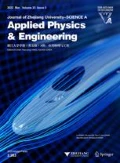Abstract
To reduce the wind-induced drag and improve the wind-resistance performance of a high-rise building, steady suction control is introduced into the building structure. Based on validation of the numerical methods by experiment with suction control over the flow separation of a 3D backward-facing step, the Reynolds stress equation model is used to investigate the drag reduction (DR) properties of a high-rise building whose side faces are controlled by all-height suction. Effects of the orifice geometrical parameters and suction flux parameters on the DR and the separation control are analyzed, and the detailed flow fields are shown to clarify the mechanism of suction control. The results indicate that suction control is very effective in reducing the wind loads on the high-rise building model, and only the dimensionless suction flux dominates. Lastly, the power consumed and the counterforce induced by suction are discussed, the suction models become the “zero-drag” model under certain suction angles.
Similar content being viewed by others
References
Cheng, Z., Shi, Z.C., Zhang, F., 1996. Reynolds number effects in tall building wind tunnel tests. Journal of Hydrodynamics, Series B, 4:56–62.
Fox, R.W., McDonald, A.T., Pritchard, P.J., 2008. Introduction to Fluid Mechanics. John Wiley & Sons Inc., NJ, USA, p.409–446.
GB50009-2001, 2002. Chinese Load Code for Design of Building Structures. Architectural Industry Press of China, Beijing.
Greenblatt, D., Wygnanski, I.J., 2000. The control of flow separation by periodic excitation. Progress in Aerospace Sciences, 36(7):487–545. [doi:10.1016/S0376-0421(00) 00008-7]
Huang, L., Huang, P.G., LeBeau, R.P., Hauser, T., 2004. Numerical study of blowing and suction control mechanism on NACA0012 airfoil. Journal of Aircraft, 41(5):1005–1013. [doi:10.2514/1.2255]
Huang, L., Huang, G., LeBeau, R., Hauser, T., 2007. Optimization of airfoil flow control using a genetic algorithm with diversity control. Journal of Aircraft, 44(4):1337–1349. [doi:10.2514/1.27020]
Kareem, A., Kijewski, T., Tamura, Y., 1999. Mitigation of motions of tall buildings with specific examples of recent applications. Wind and Structures, 2(3):201–251.
Kijewski-Correa, T., Kilpatrick, J., Kareem, A., Kwon, D.K., Bashor, R., Kochly, M., Young, B.S., Abdelrazaq, A., Galsworthy, J., Isyumov, N., et al., 2006. Validating wind-induced response of tall buildings: Synopsis of the Chicago full-scale monitoring program. Journal of Structural Engineering, 132(10):1509–1523. [doi:10.1061/(ASCE)0733-9445(2006)132:10(1509)]
Luo, J.J., Han, D.J., 2009. 3D wind-induced response analysis of a cable-membrane structure. Journal of Zhejiang University-SCIENCE A, 10(3):337–344. [doi:10.1631/2009.A0820430]
Schlichting, H., Gersten, K., 2000. Boundary-layer Theory (8th Ed.). Mayes, K., Translator. McGraw-Hill, New York, USA, p.291–320.
Simiu, E., Scanlan, R.H., 1996. Wind Effects on Structures: Fundamentals and Applications to Design (3rd Ed.). A Wiley-InterScience Publication, New York, USA, p.144–145, 297–298.
Song, Y.P., Chen, F., Yang, J., Wang, Z.Q., 2005. A numerical Investigation of Boundary Layer Suction in Compound Lean Compressor Cascades. ASME Turbo Expo: Power for Land, Sea, and Air, Reno, USA, p.167–175.
Tu, J.Y., Yeoh, G.H., Liu, C.Q., 2008. Computational Fluid Dynamics: A Practical Approach. Butterworth-Heinemann, Burlington, USA, p.250–271.
Uruba, V., Jonáš, P., Mazur, O., 2007. Control of a channel-flow behind a backward-facing step by suction/blowing. International Journal of Heat and Fluid Flow, 28(4): 665–672. [doi:10.1016/j.ijheatfluidflow.2007.04.002]
Zhang, Y.C., Qin, Y., Wang, C.G., 2004. Research on the influence of openings to static wind load of high-rise buildings. Journal of Building Structures, 25(4):112–118 (in Chinese).
Zheng, C.R., 2010. Numerical Investigation of Wind Loads on High-rise Buildings Controlled by Suction/Blowing. PhD Thesis, Harbin Institute of Technology, Harbin, China, p.72–74 (in Chinese).
Zheng, C.R., Zhang, Y.C., 2008. Numerical simulation of mean interference effects for the interfering buildings with different heights. Journal of Harbin Institute of Technology (New Series), 15(4):499–505.
Author information
Authors and Affiliations
Corresponding author
Additional information
Project (No. 59895410) supported by the National Natural Science Foundation of China
Rights and permissions
About this article
Cite this article
Zheng, Cr., Zhang, Yc. Numerical investigation on the drag reduction properties of a suction controlled high-rise building. J. Zhejiang Univ. Sci. A 11, 477–487 (2010). https://doi.org/10.1631/jzus.A0900593
Received:
Accepted:
Published:
Issue Date:
DOI: https://doi.org/10.1631/jzus.A0900593




